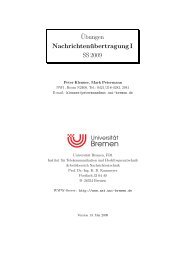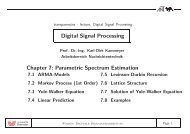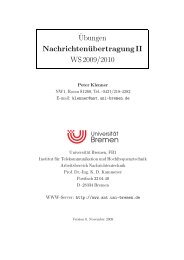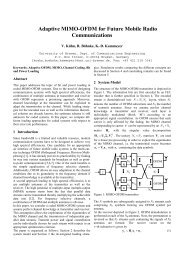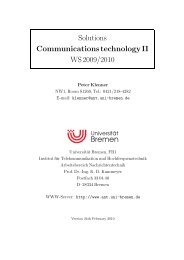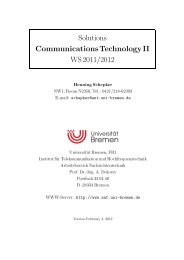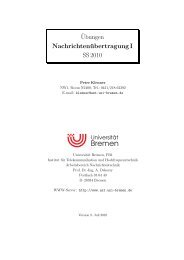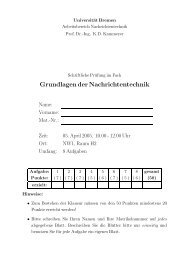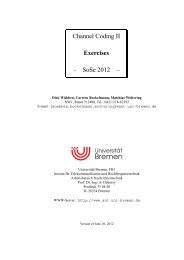Channel Coding I Exercises â WS 2012/2013 â - Universität Bremen
Channel Coding I Exercises â WS 2012/2013 â - Universität Bremen
Channel Coding I Exercises â WS 2012/2013 â - Universität Bremen
Create successful ePaper yourself
Turn your PDF publications into a flip-book with our unique Google optimized e-Paper software.
4 CONVOLUTION CODES November 7, <strong>2012</strong> 13<br />
4.5 Optimal decoding with Viterbi-algorithm<br />
Exercise 4.6<br />
Viterbi-decoding<br />
Given is a convolution code withg 0 (D) = 1+D+D 2 and g 1 (D) = 1+D 2 , where a terminated code<br />
shall be used.<br />
a) Generate the corresponding Trellis and code the information sequence u(l) = (1101).<br />
b) Conduct the Viterbi-decoding respectively for the transmitted code sequencex = (110101001011)<br />
and for the two disturbed receiving sequencesy 1 = (111101011011) andy 2 = (111110011011)<br />
and describe the differences.<br />
c) Check the results with the help of a MATLAB-program.<br />
Define the convolution code with G=[7;5], r flag=0 and term=1, generate the trellis diagram<br />
with trellis = make trellis(G,r flag) and sketch it with show trellis(trellis).<br />
Encode the information sequence u with c = conv encoder (u,G,r flag,term) and<br />
decode this sequence with<br />
viterbi omnip(c,trellis,r flag,term,length(c)/n,1).<br />
Decode now the sequences y 1 and y 2.<br />
Exercise 4.7<br />
Viterbi-decoding with puncturing<br />
Given is a convolution code with g 0 (D) = 1+D+D 2 and g 1 (D) = 1 + D 2 , out of which shall be<br />
generated a punctured code by puncturing with the scheme<br />
( ) 1 1 1 0<br />
P 1 =<br />
1 0 0 1<br />
a) Determine the code rate of the punctured code.<br />
b) Conduct the Viterbi-decoding in the case of the undisturbed receiving sequence<br />
y = (11000101) (pay attention to the puncturing!).<br />
Exercise 4.8<br />
<strong>Coding</strong> and decoding of a RSC code<br />
a) We now consider the recursive systematic convolution code with the generator polynomials˜g 0 (D) =<br />
1 and ˜g 1 (D) = (1+D+D 3 )/(1+D+D 2 +D 3 ). Generate the Trellis diagram of the code with<br />
the help of the MATLAB-command make trellis([11;15],2).<br />
b) Conduct a coding for the input sequence u(l) = (11011). The coder shall be conducted to the<br />
zero state by adding tail bits (command conv encoder (u,[11;15],2,1)). What are the<br />
output- and the state sequences?<br />
c) Now the decoding of convolution codes with the help of the Viterbi-algorithm shall be considered.<br />
For the present the sequence u(l) = (1 10110011110) has to be coded (with termination),<br />
modulated with BPSK and subsequently superposed by Gaussian distributed noise. Choose a<br />
signal-to-noise ratio of E b /N 0 = 4 dB. With the help of the program viterbi the decoding<br />
now can be made. By setting the parameter demo=1 the sequence of the decoding is represented<br />
graphically by means of the Trellis diagram. What’s striking concerning the error distribution if<br />
the Trellis is considered as not terminated?



